A discussion on the most elusive – and most important – of dressage aids: The Half Halt.
For many aspiring dressage riders, the response is considerably less literary, as they battle their way around the arena to the tune of an instructor’s chant of ‘Half halt, half halt, half halt…’
For all many top instructors will happily tell you that the half halt is the building block of all dressage work, they are often somewhat reticent when it comes to defining the nature of the beast. Let’s look at what some of the recognized authorities have to say…
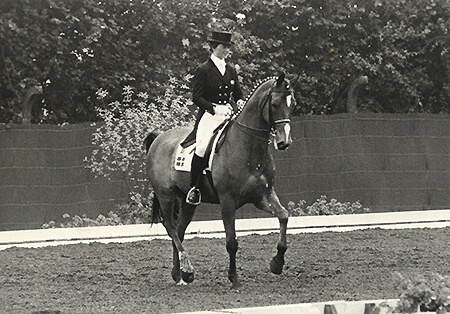
Anne Grethe Jensen and Marzog
Erik F. Herbermann in his wonderful book, The Dressage Formula, is, as always, enlightening:
The half-halt is performed in exactly the same way as the complete halt; to be correct and effective, the horse must respond to the forward driving aids. The only difference being: once the rider has driven the horse into the restraining hand, the hands yield just BEFORE the horse comes to the halt, allowing uninterrupted forward motion… as the legs and seat continue to ask for renewed activity…
Half-halts give the rider the possibility to activate the horse (a more springy stepping) without changing the rhythm, while in motion. It also serves as an introductory signal to the horse, before comers, before changing the bend and before all transitions. lt helps the rider maintain the horse’s centre of balance beneath his seat, without the horse taking the hand (leaning).
– The rider’s driving aids say, ‘A BIT MORE ACTIVITY’
– The hand says, ‘BUT STAY IN RHYTHM’ (then yields) DRIVE… RECEIVE… BECOME LIGHTER AGAIN.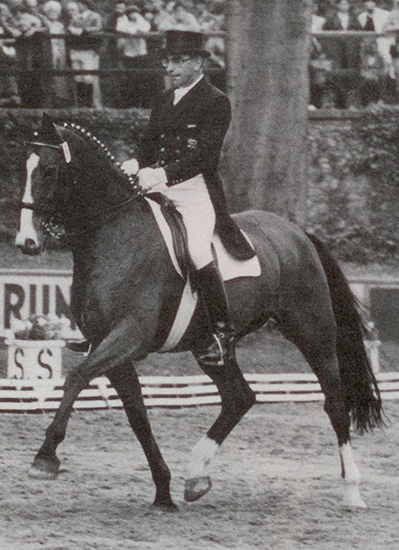
The great rider of the Spanish Riding School, Alois Podhajsky, had this to say about the half halt (or half parade):
The half-halt may be described as a ‘call to attention’ to prepare the horse for the next command of his rider. It can be employed to shorten the stride, improve the contact and collection, and give notice to the horse than an exercise requiring greater proficiency is about to be demanded.
The half-halt will help the horse to carry himself better and take a lighter contact with the bit. It may be used as a corrective, especially with a horse that is inclined to lie heavily on the reins.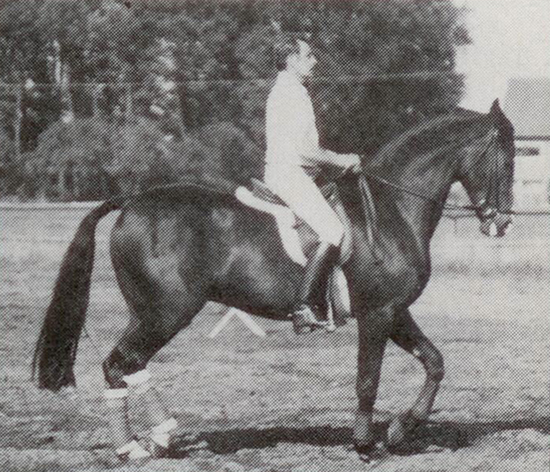
In his Riding Logic, Wilhelm Museler notes:
…all these half-parades are executed in the same way: by driving the horse from rear to front into the passively resisting hand.
Said quickly by one of the world’s great dressage authorities it all sounds so easy, for most rider’s the half-halt is a good deal more difficult to achieve.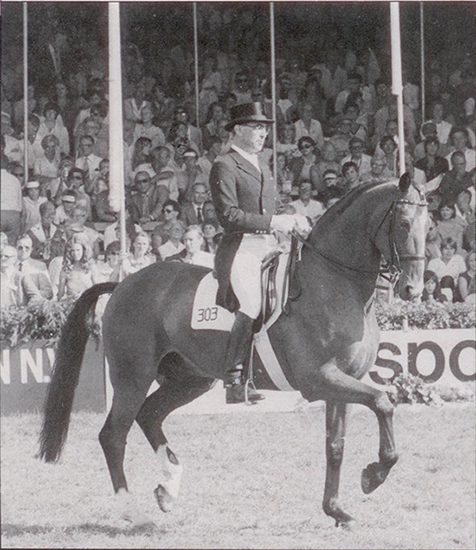
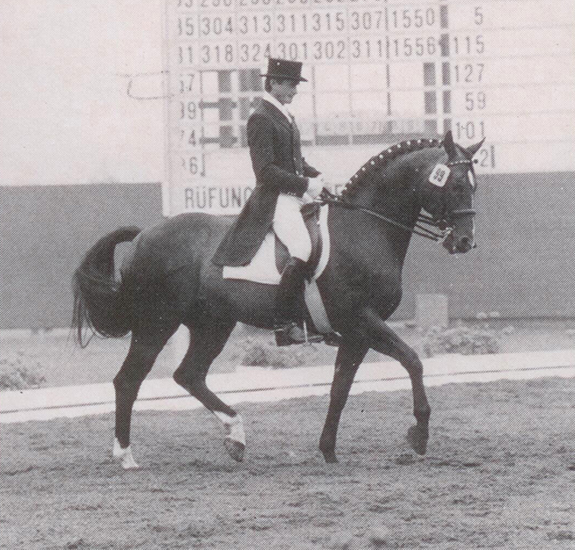
The German Dressage authority, Waldemar Seunig outlines the aids for the half halt, by first discussing the aids for the full halt:
Stimulating the forward reach of the hindquarters, followed by halting them by leg pressure on both sides of the horse. Loading action of the seat by pushing the small of the back farther forward, keeping the upper body upright and sustaining action of the hands. More or less accepting pull on the reins, as necessary, with unchanged posture of the rider’s upper body and passive legs.
If the controls do not co-operate in the sequence given – say, the accepting pull on the reins is made too early or the weight action becomes too much of a driving action because the upper body leans backwards excessively – the stop cannot be soft and fluid but is abrupt.
The controls employed for the half halt are similar, the sole difference being that the hands allow motion to continue accordingly. Driving controls persist and outweigh the restraining ones. Stretching in one’s seat and closing one’s fingers will suffice for sensitive horses.
For all of the theory, perhaps the best way to gain a real understanding of the execution and timing of the half-halt, is to watch a gifted instructor in action an instructor like Australia’s National Dressage Coach in the early 1980’s, Wolfgang Holzel. Dr Holzel asks the rider over and over again for half-halts, always stressing that the aid must be light and subtle.
Half-halt, then take the hands forward along the mane. Do the same after the next half-halt. Still hands and soft hands. Always the half-halt from the hind legs to the hand – not from the hand to the hindlegs. The rider’s legs on the horse, squeeze a bit to the standing hand. Don’t go back with the hands. DON’T go back with the hands, the half-halt is from the leg and seat to the hands. Always softer, always lighter… not one half halt but many half halts.
Again, it was Dr Holzel’s colleague, Dr Dietmar Specht who provided one of the most elegant definitions of the half-halt… to include the horse more.
So there it is. The dressage aid that is as elusive as that mythical equine the unicorn… the dressage aid that is the building block for all your work. Hopefully, the next time your instructor commands half-halt… you will remember the advice from our galaxy of international experts and respond to the delight of your instructor, your horse, and most importantly, yourself.
This article first appeared in the August 1985 issue of THM.
Breeding a dressage star in Australia?
Go to www.ihb.com.au and choose from the best European bloodlines… Like Golden Romance Malleret…
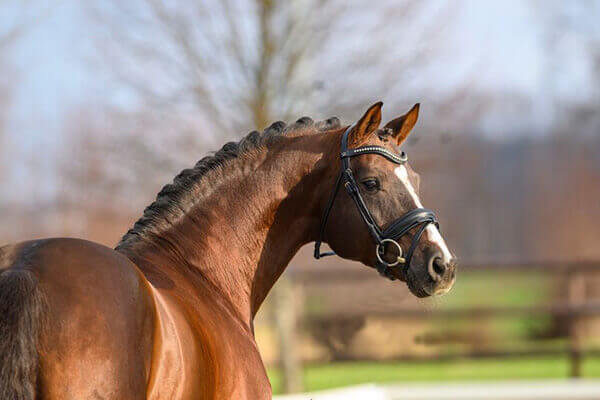



I think one of the main problems associated with the ‘half-halt” for riders is that it can only be executed by a very well trained horse. It is an advanced movement. Half the time it’s asked for when the horse is not ready nor capable, has no idea what is expected because it hasn’t yet learnt to understand the subtle aids required. A rider who hasn’t ridden such a well trained horse is also unable to understand what’s required either frankly. The horse needs to be fully engaged, balanced, forward, on the bit carrying itself full of tactile modulated impulsion before half-halt can be asked for or used effectively.
The name is also confusing, it’s more like asking for suspended impulsion without losing any of it. When I see a horse suddenly asked into a collected walk from a bouncy canter, stepping forward and high like a ballerina walking on air, that was a result of a half-halt well executed in the transition
Good very clear examples of half-halts can be found watching stylish show jumping riders in action on a very well schooled horses. They use half halts all the time, to steady the horse and prepare it for unleashing a great deal of power to get over some very big fences, turn sharp corners, ask for attention, to generally momentarily reset the dial while fully in motion, even at a heady gallop. The worse the rider and more badly schooled the horse the more ugly and forced the execution where strong hands and seat become the primary source to achieving the half halt.
The horse should transfer to the hind legs just a little more, lighten the forehand a little more and all in a breath be ready to move forward in the way the rider desires, be it trot to walk, canter to extended canter, into a corner etc. Rather than be pulled back and sat on hard it’s a very subtle ask.
Half halts in dressage or any discipline are no different, only maybe differing in subtlety but they really shouldn’t by much at all. Half halts make whatever is coming next more accurate, expressive, calm or all three. They come from a place of instant secure re-balancing where the horse is also asked to concentrate.
Certainly they can be over used IMO. They should also ideally be as imperceptible as any other aid. Very busy hands etc, eg coming in and during pirouette for example are not nice to look at, nor hands maintaining every step in the rhythm of passage for another. Common as they are the horse should be relaxed and willing enough to accept the waiting aids between movements and transitions where it continues in perfect rhythm until alerted with something like a half halt and rebalance. Each different movement pace and change of such requires a subtle rebalancing of the horse, that’s all you’re asking it with half-halts.
Thanks to a brilliant horse, my take on that at any rate.